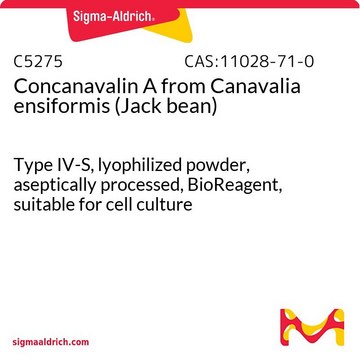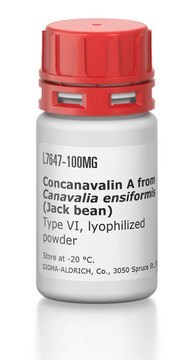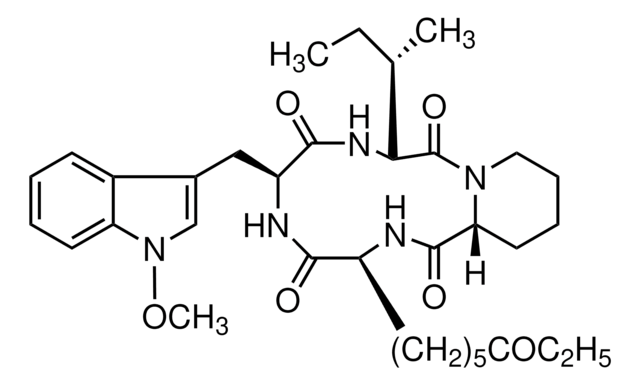C0412
Concanavalin A from Canavalia ensiformis (Jack bean)
Type IV-S, lyophilized powder, γ-irradiated, BioReagent, suitable for cell culture
Synonim(y):
Con A
About This Item
Polecane produkty
Poziom jakości
sterylność
γ-irradiated
typ
Type IV-S
linia produktu
BioReagent
Formularz
lyophilized powder
metody
cell culture | mammalian: suitable
zanieczyszczenia
salt, essentially free
rozpuszczalność
PBS: 5 mg/mL, slightly hazy
H2O: soluble, slightly hazy
temp. przechowywania
−20°C
Szukasz podobnych produktów? Odwiedź Przewodnik dotyczący porównywania produktów
Powiązane kategorie
Zastosowanie
- to induce spleen blastogenesis
- to generate ConA blast targets from B6 and lpr spleen cells
- to stimulate splenic lymphocytes from estrogen-and placebo-treated mice
Działania biochem./fizjol.
Komentarz do analizy
Hasło ostrzegawcze
Danger
Zwroty wskazujące rodzaj zagrożenia
Zwroty wskazujące środki ostrożności
Klasyfikacja zagrożeń
Repr. 2 - Resp. Sens. 1 - Skin Sens. 1
Kod klasy składowania
11 - Combustible Solids
Klasa zagrożenia wodnego (WGK)
WGK 3
Temperatura zapłonu (°F)
Not applicable
Temperatura zapłonu (°C)
Not applicable
Środki ochrony indywidualnej
dust mask type N95 (US), Eyeshields, Faceshields, Gloves
Wybierz jedną z najnowszych wersji:
Masz już ten produkt?
Dokumenty związane z niedawno zakupionymi produktami zostały zamieszczone w Bibliotece dokumentów.
Klienci oglądali również te produkty
Nasz zespół naukowców ma doświadczenie we wszystkich obszarach badań, w tym w naukach przyrodniczych, materiałoznawstwie, syntezie chemicznej, chromatografii, analityce i wielu innych dziedzinach.
Skontaktuj się z zespołem ds. pomocy technicznej











